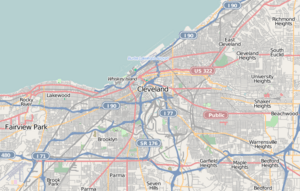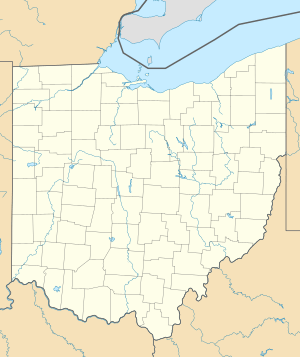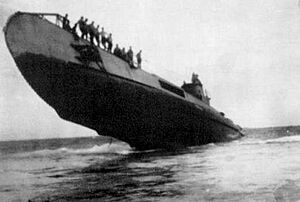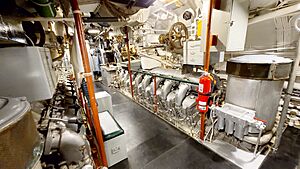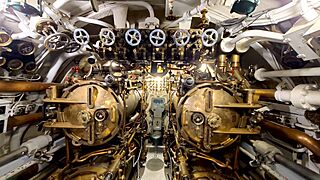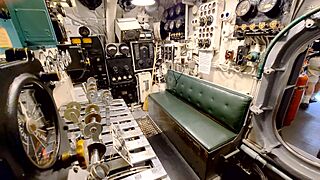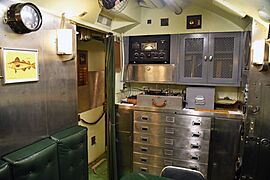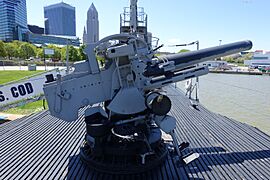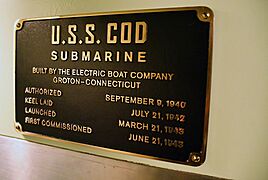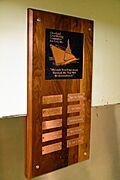USS Cod facts for kids
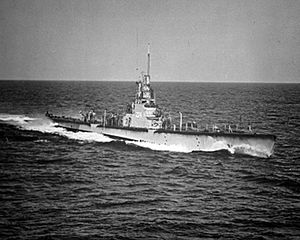
USS Cod (SS-224) underway off Block Island, Rhode Island in December 1951
|
|
| History | |
|---|---|
| Name | USS Cod |
| Namesake | Cod |
| Ordered | 9 September 1940 |
| Builder | Electric Boat Company, Groton, Connecticut |
| Laid down | 21 July 1942 |
| Launched | 21 March 1943 |
| Sponsored by | Mrs. G.M. Mahoney |
| Acquired | 21 June 1943 |
| Commissioned | 21 June 1943 |
| Decommissioned | 21 June 1954 |
| In service | 21 March 1943 |
| Out of service | 15 December 1971 |
| Reclassified | AGSS-224, 1 December 1962, IXSS-224, 30 June 1971 |
| Stricken | 15 December 1971 |
| Honors and awards |
Seven |
| Status | Museum ship and memorial in Cleveland, Ohio since 1 May 1976 |
| Badge | 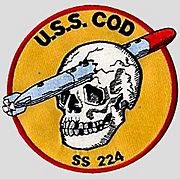 |
| General characteristics | |
| Class and type | Gato-class diesel-electric submarine |
| Displacement |
|
| Length | 312 ft (95 m) |
| Beam | 27 ft 3 in (8.31 m) |
| Draft | 17 ft (5.2 m) maximum |
| Propulsion |
|
| Speed |
|
| Range | 11,000 nautical miles (20,000 km; 13,000 mi) surfaced at 10 kn (19 km/h; 12 mph) |
| Endurance |
|
| Test depth | 300 ft (90 m) |
| Complement | 6 officers, 54 enlisted |
| Armament |
|
|
USS Cod (Submarine)
|
|
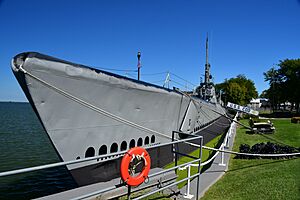
USS Cod moored in Cleveland, Ohio's North Coast Harbor
|
|
| Location | Cleveland, Ohio |
| Area | Less than one acre |
| Built | 1942 |
| Built by | Electric Boat Company, Groton, Connecticut |
| Architectural style | Submarine |
| NRHP reference No. | 86000088 |
| Significant dates | |
| Added to NRHP | 14 January 1986 |
| Designated NHL | 14 January 1986 |
The USS Cod (SS/AGSS/IXSS-224) is a famous United States Navy submarine. She is named after the cod fish, a popular food fish. The Cod was launched on March 21, 1943, and officially joined the Navy on June 21, 1943.
Today, the Cod is a National Historic Landmark. She is kept as a museum ship and a memorial in Cleveland, Ohio. You can visit her from May to November each year.
Contents
The Cod was built by the Electric Boat Company in Groton, Connecticut. Her construction started on July 21, 1942. The submarine's powerful diesel engines were made by General Motors in Cleveland, Ohio. She was launched into the water on March 21, 1943. Mrs. G.M. Mahoney was her sponsor, a special person who officially names the ship. The Cod was officially ready for service on June 21, 1943. Commander James C. Dempsey was her first captain. He was already famous for sinking a Japanese destroyer in World War II.
Cod in World War II
The USS Cod played an important role in World War II. She completed seven successful patrols, mostly in the Pacific Ocean.
First Patrol: October 1943 – January 1944
The Cod arrived in Brisbane, Australia, in October 1943. She began her first war patrol in the South China Sea. She searched for enemy ships but found few targets. After one attack, she returned to Fremantle, Australia, for repairs and supplies.
Second Patrol: February – March 1944
Her second patrol took her back to the South China Sea. On February 16, she sank a small boat called a sampan. She also sank two Japanese cargo ships. After attacking a third ship, Japanese escort ships dropped depth charges, forcing her to dive deep for safety.
Third Patrol: March – June 1944
After getting ready in Fremantle, the Cod sailed to the Sulu Sea and the South China Sea. On May 10, she attacked a large group of 32 enemy ships. She managed to sink a Japanese destroyer called Karukaya and a cargo ship. Enemy ships then chased her with depth charges.
Fourth Patrol: July – August 1944
The Cod went on her fourth patrol from July to August. She patrolled near Luzon and Java. During this time, she sank a converted net tender and a landing craft. She returned to Fremantle after another successful mission.
Fifth Patrol: September – November 1944
Her fifth patrol was in the Philippines. On October 5, she sank a cargo ship. Two days later, she badly damaged a tanker. She also helped rescue aircraft carrier pilots. These pilots were flying missions to prepare for the Battle of Leyte. After this patrol, the Cod went to Pearl Harbor and then to a shipyard for major repairs.
Sixth Patrol: March – May 1945
In March 1945, the Cod began her sixth patrol in the East China Sea. Her main job was to be a "lifeguard" submarine. This meant she was ready to rescue pilots who crashed. On April 17, she used her deck gun to sink a tugboat and rescued three survivors. A few days later, she sank a Japanese minesweeper. During this patrol, a fire broke out in her torpedo room. The brave crew put out the fire. Sadly, one crew member, Andrew G. Johnson, was lost overboard during this event. This was the only time the Cod lost a crew member in World War II.
Seventh Patrol: May 1945 – June 1946
After getting supplies in Guam, the Cod went to the Gulf of Siam. On July 9 and 10, she performed a very special rescue. A Dutch submarine, the O-19, was stuck on a reef. The Cod rescued all of its crew members. Since the Dutch submarine could not be saved, the Cod destroyed it. This was the only time in history that one submarine rescued the crew of another submarine from a different country.
After dropping off the Dutch sailors, the Cod continued her patrol. She attacked many small enemy boats, like junks and barges. She always checked for civilians first before sinking the boats. On August 1, an enemy plane attacked the Cod. She had to dive quickly, leaving some of her crew behind. Luckily, another submarine rescued them two days later.
When the Cod returned to Fremantle on August 13, 1945, the crew of the O-19 was there to celebrate. During the party, everyone learned that Japan had surrendered, ending World War II. To remember the rescue and the celebration, a special symbol was added to the Cod's battle flag: the name O-19 under a martini glass. The Cod then sailed home and was taken out of service in June 1946.
After the War: 1946 – 1971
The Cod was kept in storage for a few years. In 1951, she was brought back into service. She helped with NATO training exercises to practice finding enemy submarines. During the Cold War, the Cod traveled to places like Newfoundland, Cuba, and South America.
In 1954, the Cod was taken out of active service again. In 1959, she was moved through the St. Lawrence Seaway to Cleveland, Ohio. There, she became a training ship for Navy reservists. These reservists would practice their skills on the Cod during weekend drills. The Cod was officially removed from the Navy's list of ships on December 15, 1971.
Awards and Honors
The USS Cod is recognized for sinking more than 12 enemy ships during World War II. All seven of her war patrols were very successful. Because of this, she earned seven battle stars for her service. Her battle flag and conning tower proudly display the cocktail glass symbol above the name O-19. This remembers the unique submarine rescue and the celebration that followed.
| American Campaign Medal | |||
| Asiatic-Pacific Campaign Medal with seven battle stars |
World War II Victory Medal | National Defense Service Medal | Philippine Liberation Medal |
A Museum Ship in Cleveland
In 1976, a group of people in Cleveland worked to save the Cod. They wanted to turn her into a memorial. The United States Navy agreed, and the Cod opened for public tours on May 1, 1976. In 1986, the U.S. government named the Cod a National Historic Landmark. You can visit this memorial every year from May to November.
The Cod is special because she is the only World War II submarine museum in the U.S. that still has her original design. No new stairways or doors were cut into her hull for visitors. This means visitors use the same ladders and hatches that the crew used during the war. Many parts of the ship, like her deck gun, radar, and all five diesel engines, have been fixed and can still work.
Cleveland has a special connection to the Cod. Her main diesel engines were built there. The museum even has extra engines from another World War II submarine to use for parts. The Cod also has an amateur radio station, W8COD. It takes part in radio contests and events.
In June 2021, the Cod was towed to Erie, Pennsylvania, for important repairs. This was the first time she had been in dry dock for repairs since 1963. The project cost over a million dollars and helped fix her underwater hull. The Cod returned to Cleveland in August 2021. On June 21, 2023, the Cod celebrated her 80th anniversary since she first joined the Navy during World War II.
Gallery


